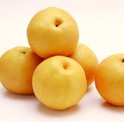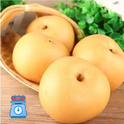Hey there, fruit lovers! As a supplier of Shinseiki Pears, I'm stoked to share some insider tips on how to select the freshest ones. Shinseiki Pears are a real gem in the fruit world, known for their crisp texture, sweet flavor, and juicy goodness. So, let's dive right in and learn how to pick the best ones!
Appearance Matters
First things first, take a good look at the pear's appearance. A fresh Shinseiki Pear should have a smooth, unblemished skin. Avoid pears with bruises, cuts, or soft spots, as these are signs of damage or spoilage. The skin color should be a vibrant yellowish-green, with a slight blush on the side that was exposed to the sun. This natural blush is a good indicator of ripeness and flavor.
The shape of the pear is also important. Shinseiki Pears are typically round to oval in shape, with a slightly tapered end. A well-formed pear is more likely to be sweet and juicy. Avoid pears that are misshapen or have an irregular texture, as these may not have developed properly.
Feel the Firmness
Next, give the pear a gentle squeeze. A fresh Shinseiki Pear should be firm but not rock-hard. You want to feel a slight give when you apply pressure, indicating that the pear is ripe but still crisp. If the pear is too soft, it may be overripe and have a mushy texture. On the other hand, if it's too hard, it may not be fully ripe and could lack flavor.
Another way to test the firmness is to gently press your thumb near the stem end of the pear. If it gives slightly, the pear is likely ready to eat. If it's still very hard, it may need a few more days to ripen.
Check the Stem
The stem of the pear can also provide clues about its freshness. A fresh Shinseiki Pear should have a green, intact stem. If the stem is brown or dry, it may indicate that the pear is not as fresh. Additionally, a loose or missing stem could be a sign that the pear has been mishandled or is past its prime.


Smell the Aroma
Believe it or not, the smell of a pear can tell you a lot about its flavor. A fresh Shinseiki Pear should have a sweet, fragrant aroma. If it doesn't have much of a smell, it may not be fully ripe. On the other hand, if it has a strong, unpleasant odor, it could be overripe or spoiled.
Compare with Other Varieties
If you're new to Shinseiki Pears, it can be helpful to compare them with other pear varieties. For example, you can check out some other popular pear types like the Best Pears For Eating. This can give you a better idea of what to expect in terms of flavor, texture, and appearance.
Another great variety to compare with is the Hosui Asian Pears. Hosui pears are known for their sweet, juicy flavor and crisp texture, similar to Shinseiki Pears. By comparing the two, you can see the unique characteristics of each variety and decide which one you prefer.
You might also want to take a look at the Qiuyue Asian Pear. Qiuyue pears have a slightly different flavor profile, with a more delicate sweetness and a softer texture. Comparing these different varieties can help you develop a better palate for pears and make more informed choices when selecting Shinseiki Pears.
Ripening at Home
If you buy Shinseiki Pears that are not quite ripe, don't worry! You can easily ripen them at home. Simply place the pears in a paper bag with an apple or a banana. These fruits release ethylene gas, which helps to speed up the ripening process. Check the pears daily by gently squeezing them to see if they're ready to eat. Once they reach the desired firmness, you can remove them from the bag and store them in the refrigerator to slow down the ripening process.
Storing Fresh Shinseiki Pears
To keep your Shinseiki Pears fresh for as long as possible, store them in the refrigerator. Place them in a plastic bag or a container with a lid to prevent them from drying out. Fresh Shinseiki Pears can last for up to two weeks in the refrigerator.
If you have ripe pears that you're not ready to eat right away, you can also freeze them. Simply peel, core, and slice the pears, then place them in a freezer-safe bag or container. Frozen Shinseiki Pears can be used in smoothies, pies, or other recipes.
Why Choose Our Shinseiki Pears?
As a supplier, I take pride in offering the freshest and highest-quality Shinseiki Pears. Our pears are grown using sustainable farming practices, ensuring that they're not only delicious but also environmentally friendly. We carefully select each pear to make sure it meets our strict quality standards, so you can be confident that you're getting the best.
Whether you're a fruit stand owner, a grocery store manager, or just someone who loves fresh fruit, I'd love to work with you. If you're interested in purchasing Shinseiki Pears from us, please don't hesitate to reach out. We can discuss your specific needs and provide you with a competitive quote.
Conclusion
Selecting fresh Shinseiki Pears is all about using your senses. Look for a smooth, unblemished skin, feel for the right firmness, check the stem, and smell the aroma. By following these tips, you'll be able to pick the juiciest, sweetest Shinseiki Pears every time. And if you're in the market for these amazing pears, give us a shout. We're here to help you get the best fruit for your business or your family.
References
- General knowledge of fruit selection and pear varieties.
- Experience as a Shinseiki Pear supplier.





